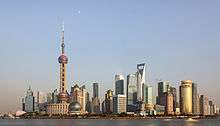Thames Town
| Thames Town 泰晤士小鎮 | |
|---|---|
| District | |
 | |
| Country | People's Republic of China |
| Municipality | Songjiang District |
| Time zone | China Standard (UTC+8) |
Thames Town (Chinese: 泰晤士小鎮; pinyin: tài wù shì xiǎo zhèn) is the English name for a new town in Songjiang District, about 30 kilometres (19 mi) from central Shanghai, China. It is named after the River Thames in London, United Kingdom. The architecture is themed according to classic British market town styles. There are cobbled streets, Victorian terraces and corner shops.
Thames Town is a part of Songjiang New City,[1] in Songjiang District.[2] The town is 4 kilometres (2.5 mi) from the Songjiang New City station on Shanghai Metro Line 9. The G60 Shanghai–Kunming Expressway, formerly known as the Huhang Expressway, passes to its south.[3]
While Songjiang District is an ancient prefecture which predates by far the establishment of Shanghai, Songjiang New City is a new development, intended to draw population away from central Shanghai.[4] Within this city, one of the objectives for Thames Town was to provide accommodation for the staff of the new universities in adjacent Songjiang University Town.[5] These developments were a part of the One City, Nine Towns initiative, which was passed by the Shanghai Planning Commission in 2001. This policy lasted for the duration of the tenth five year plan (2001–2005). The "one city" of this policy was Songjiang New City, where an English theme was used for Thames Town. The "nine towns" of the policy were each sited in one of the other suburban districts of Shanghai, and each was also given their own theme. Other Western themes used to date are Scandinavian, Italian, Spanish, Canadian, Dutch and German.[6]
The architectural firm of Atkins was given responsibility for planning Songjiang New City and designing Thames Town.[5] The main developers for the town were Shanghai Songjiang New City Construction and Development, and Shanghai Henghe Real Estate. Thames Town was completed in 2006, occupying an area of 1 square kilometre and designed for a population of 10,000.[2] It cost 5 billion yuan to construct.

The town consists mostly of low-density, single-family housing, with few commercial premises or community facilities. Although the houses sold rapidly, most purchases were by the relatively wealthy, as investments or second homes, and house prices rose to a high level. The proportion of owners taking up permanent residence was low,[7] and Business Insider described it as a "virtual ghost town".[8] Nevertheless, a similar English-style town is planned near Beijing.[9]
Some of the architecture has been directly copied from buildings found in England, including the church (modelled on Christ Church, Clifton Down in Bristol) a pub and fish and chip shop (copied from buildings in Lyme Regis, Dorset).[10] and The Cross in Chester. The town has become very popular as a location for wedding photography,[11] with the picturesque church and main square often used as a backdrop.[10]
References
- ↑ den Hartog (2010a), p. 34
- 1 2 den Hartog (2010b), p. 118
- ↑ Wang, Kundu & Chen (2010), p. 335
- ↑ den Hartog (2010a), p. 28
- 1 2 den Hartog (2010b), p. 122
- ↑ den Hartog (2010a), pp. 34–36
- ↑ Wang, Kundu & Chen (2010), pp. 337–339
- ↑ Julie Zeveloff (14 June 2011). "Welcome To The Bizarre Chinese Ghost Town That Looks Like It Was Plucked From The British Countryside". Business Insider. BBC. Retrieved 13 March 2013.
- ↑ Robin Banerji; Patrick Jackson (14 August 2012). "China's ghost towns and phantom malls". BBC News. Retrieved 14 August 2012.
- 1 2 Lim, Louisa (12 December 2006). "China Gets Its Own Slice of English Countryside". World News. NPR. Retrieved 11 April 2012.
- ↑ den Hartog (2010b), p. 126
Sources
- den Hartog, Harry (2010a). "Urbanisation of the Countryside". In den Hartog, Harry. Shanghai New Towns: Searching for community and identity in a sprawling metropolis (PDF). Rotterdam: 010 Publishers. pp. 7–42. ISBN 978-90-6450-735-9.
- den Hartog, Harry (2010b). "Thames Town, Songjiang District". In den Hartog, Harry. Shanghai New Towns: Searching for community and identity in a sprawling metropolis. Rotterdam: 010 Publishers. pp. 118–127. ISBN 978-90-6450-735-9.
- Wang, Lan; Kundu, Ratoola; Chen, Xiangming (2010). "Building for what and whom? New town development as planned suburbanization in China and India". In Clapson, Mark; Hutchison, Ray. Suburbanization in Global Society. Bingley: Emerald. pp. 319–346. ISBN 978-0-85724-347-8.
See also
- No Chinese
- Jackson Hole, China
- Europe Street
- Ju Jun - known as "Orange County, China"
External links
- Thames Town (official site)
- Pubs, privet and parody as China builds little Britain by the Yangtse , The Guardian, 16 August 2006.
- Shanghai surprise ... a new town in ye olde English style, The Guardian, 2 June 2004.
- Ye Olde Shanghai, Time, 14 February 2005.
- Thames Town Documentary Photography series by Dave Wyatt, July 2008
- DowntownSongjiang Thames Town review Downtown Songjiang review & photos of Thames Town, October 2011
Coordinates: 31°02′10″N 121°11′26″E / 31.036°N 121.1905°E
